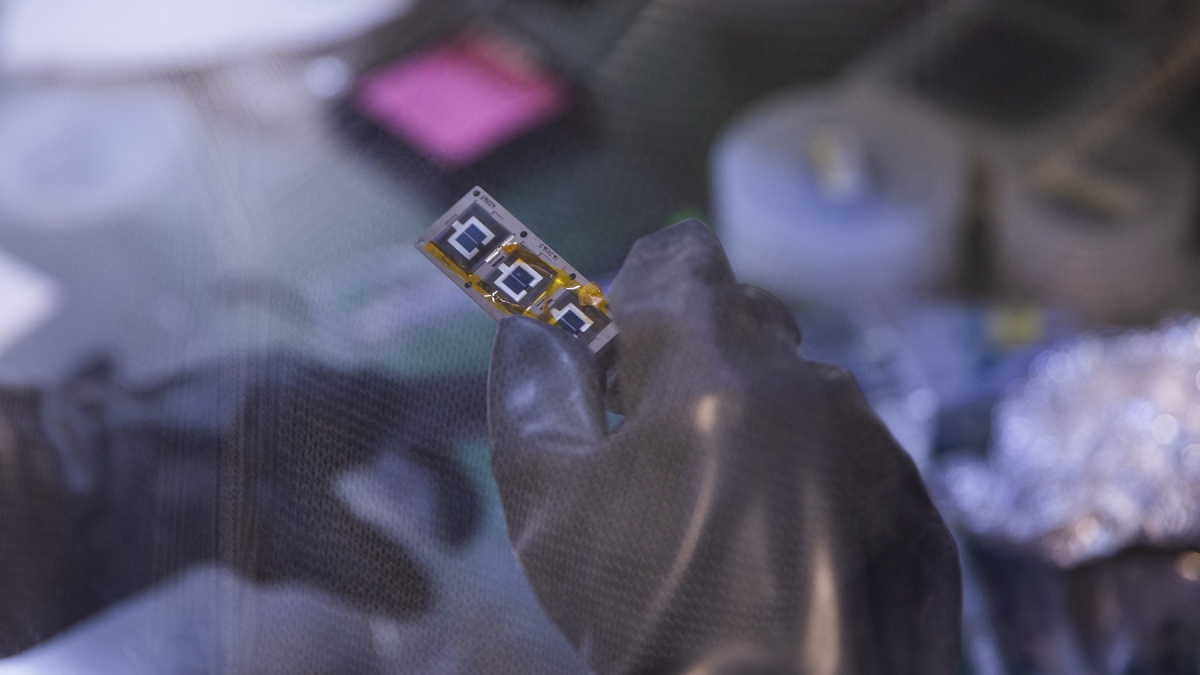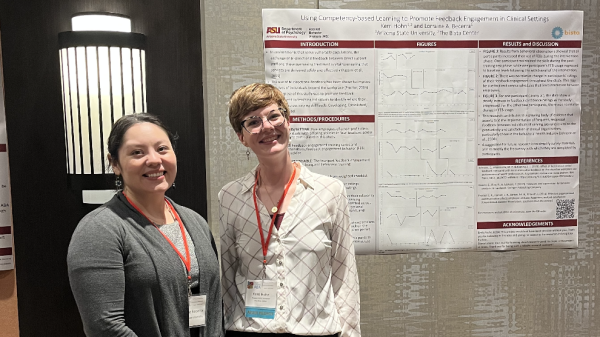Layered solar cell technology boosts efficiency, affordability
ASU researchers are pioneers in new solar cell technology

The future’s getting brighter for solar power. Researchers from Arizona State University and the University of Colorado Boulder have created a low-cost solar cell with one of the highest power-conversion efficiencies to date, by layering cells and using a unique combination of elements.
“Solar cell power-conversion efficiency is a key driver of the cost of solar power,” explained Zachary Holman, an associate professor in ASU’s School of Electrical, Computer and Energy Engineering and a co-author of a Science paper about the technology. “The installation of solar panels on your roof now costs five times more than the panels themselves, so you want to use the most efficient panels, which have the most efficient cells.”
The researchers took a perovskite solar cell, a crystal structure that's designed to harvest higher energy photons, and layered it on top of a silicon solar cell, which captures more photons in the infrared part of the spectrum — which is made up of radiant energy that we cannot see, but we can feel as heat.
“Silicon can be as efficient as 45% at converting low-energy photons,” said Zhengshan (Jason) Yu, an assistant research professor at Arizona State University and co-author of the paper. “Pairing (it) with a top cell that is efficient at converting high-energy photons can dramatically improve the overall device efficiency.”
Combined, the perovskite raises a 21% silicon solar cell up to an efficiency of 27% — increasing it by almost a third.
For years, silicon solar cells have been the standard in the solar power industry. But current silicon-based cells only convert 20–22% of the sun’s energy into usable electricity on average, and they max out at about 27%.
The average efficiency of solar panels is lower than the maximum efficiency, because no matter how good an individual solar cell is, connecting many of them in a large panel will cause a power loss of about three percentage points — kind of like a sports team only being as good as its average player. But if you can raise the overall efficiency, you don't have to install as many panels to get the same amount of power.
What dramatically improves efficiency is to put another solar cell on top of an existing one — and that's exactly what the researchers did.
An affordable secret formula
This isn’t the first time researchers have layered solar cells to gain efficiency. The concept, also known as tandem or multijunction solar cells, was first introduced in the 1970s — and the world record for solar cell efficiency is already over 45%. However, it came at a hefty price: $80,000 per square meter, due to the fact the cells were grown one atomic layer at a time, creating one big, single crystal. Probably not a cost the average homeowner or business can afford.
Holman, Yu and their fellow researchers are pioneers in a new direction of layered solar cells, using perovskites and silicon, which cost more than a hundred times less.
They started working in close collaboration with first co-author Michael McGehee, a professor in the Department of Chemical and Biological Engineering at CU Boulder, fewer than five years ago with the concept of using less expensive materials on top of the silicon. At first they achieved about 13% efficiency, but through technological improvements have been able to more than double that number.
Their secret formula involves a unique triple-halide alloy of chlorine, bromine and iodine.
Each solar cell material has a single wavelength, or color of light, that it best converts into electricity. Unique to perovskites, which are a family of materials, this best wavelength can be adjusted by swapping some elements in the crystal with others.
The addition of bromine, for example, can tune a perovskite so that its best wavelength is perfect for pairing with silicon in a tandem solar cell. However, when used with iodine and exposed to light, these elements don’t always stay in place. Previous studies have tried to use chlorine and iodine together, but due to the differing particle sizes of these elements, not enough chlorine could fit into the perovskite crystal structure. But by using different amounts of chlorine, bromine and iodine, the researchers figured out a way to shrink the crystal structure, allowing more chlorine to fit in — stabilizing and improving the cell’s efficiency.
With the solar power market growing around 30% per year, cost and longevity are also major considerations for new technologies to become mainstream. Fortunately, perovskites are inexpensive and, even after 1,000 hours, or almost 42 days, of intensive light and heat testing, these new solar cells showed a minimal change in their initial efficiency.
Holman, Yu and McGehee are optimistic about the potential of this new perovskite material in tandem solar cells.
“We took a product that is responsible for a $30 billion a year industry and made it 30% better,” McGehee said. “That’s a big deal. “Not only has the team’s cell now surpassed the maximum efficiency of a silicon-only solar cell, we believe it can take us over 30% efficiency and that it can be stable.”
Additional authors of this study include Jixian Xu, co-first author and postdoctoral researcher; Jérémie Werner, postdoctoral researcher; and Daniel Witter, graduate student in chemical and biological engineering at the University of Colorado Boulder; Caleb Boyd, co-first author, visitor at the University of Colorado Boulder and NREL and graduate student at Stanford University; as well as researchers from the National Renewable Energy Laboratory and Stanford University.
Top photo: Perovskite/silicon tandem solar cells created by ASU researchers are transforming mainstream silicon technology and lowering the cost of solar energy. Photo by Erika Gronek/ASU
More Science and technology

Miss Arizona, computer science major wants to inspire children to combine code and creativity
Editor’s note: This story is part of a series of profiles of notable spring 2024 graduates. “It’s bittersweet.” That’s how Tiffany Ticlo describes reaching this milestone. In May, she will graduate…

ASU applied behavior analysis program recognized in Four Corners region
Helping students with learning disabilities succeed in school and modeling effective communication skills are just two examples of how applied behavioral analysis improves lives. Since launching…

Redefining engineering education at West Valley campus
Editor's note: This story originally appeared in the summer 2024 issue of ASU Thrive magazine. What makes the School of Integrated Engineering different from other engineering schools? We listened…